CLWM4100 Taxation Law: Comprehensive Case Study on Australian Taxation
VerifiedAdded on 2023/06/07
|9
|1584
|260
Case Study
AI Summary
This case study delves into various aspects of Australian taxation law, focusing primarily on determining tax residency for a company operating both within Australia and internationally, and analyzing capital gains tax (CGT) implications for various asset sales. The analysis of tax residency involves applying section 6(1) of the Income Tax Assessment Act, considering factors such as the location of business operations, central management and control, and shareholder influence, referencing relevant case law like Bywater Investments Ltd & Ors V Commissioner of Taxation. The CGT component calculates taxable amounts from the sale of different assets, including land, shares, and jewelry, taking into account acquisition costs, indexation, and potential capital losses, referencing section 8-2 and 186-5 of the ITAA 97. Additionally, the case study addresses the deductibility of expenses such as loan interest and media campaign costs under section 8-1 of the Income Tax Assessment Act 1997, ultimately providing a comprehensive overview of key taxation principles and their practical application.
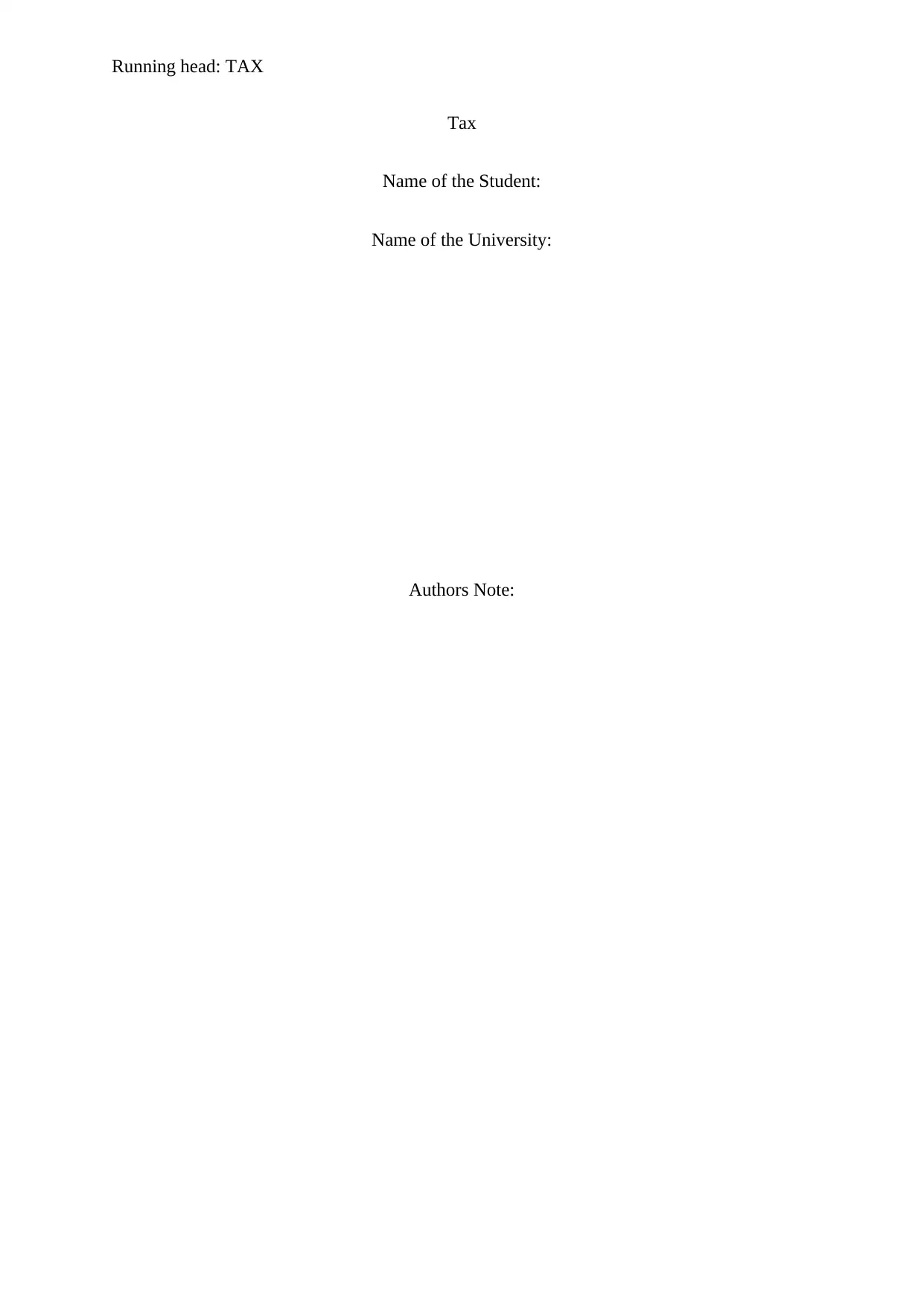
Running head: TAX
Tax
Name of the Student:
Name of the University:
Authors Note:
Tax
Name of the Student:
Name of the University:
Authors Note:
Paraphrase This Document
Need a fresh take? Get an instant paraphrase of this document with our AI Paraphraser
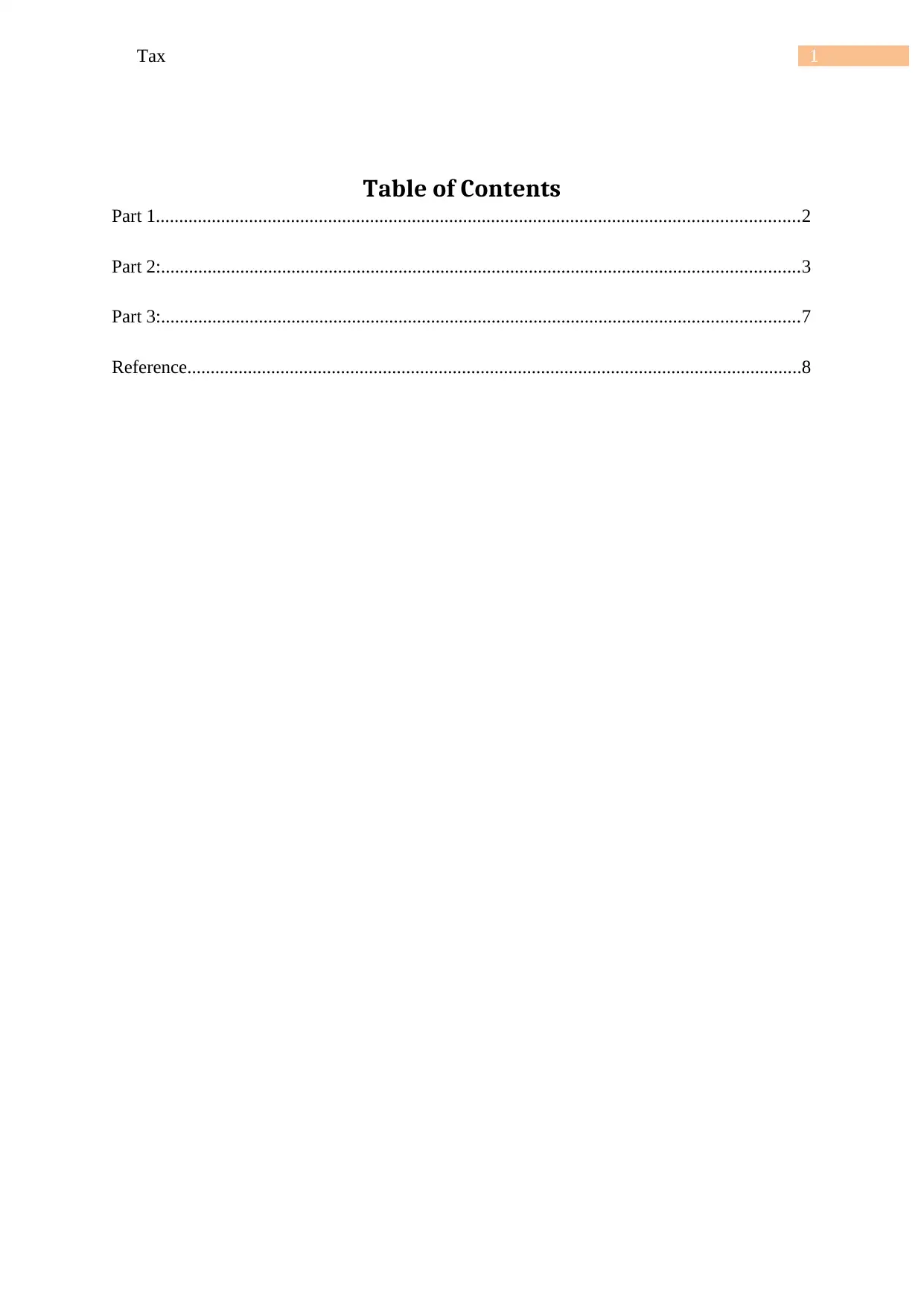
1Tax
Table of Contents
Part 1..........................................................................................................................................2
Part 2:.........................................................................................................................................3
Part 3:.........................................................................................................................................7
Reference....................................................................................................................................8
Table of Contents
Part 1..........................................................................................................................................2
Part 2:.........................................................................................................................................3
Part 3:.........................................................................................................................................7
Reference....................................................................................................................................8
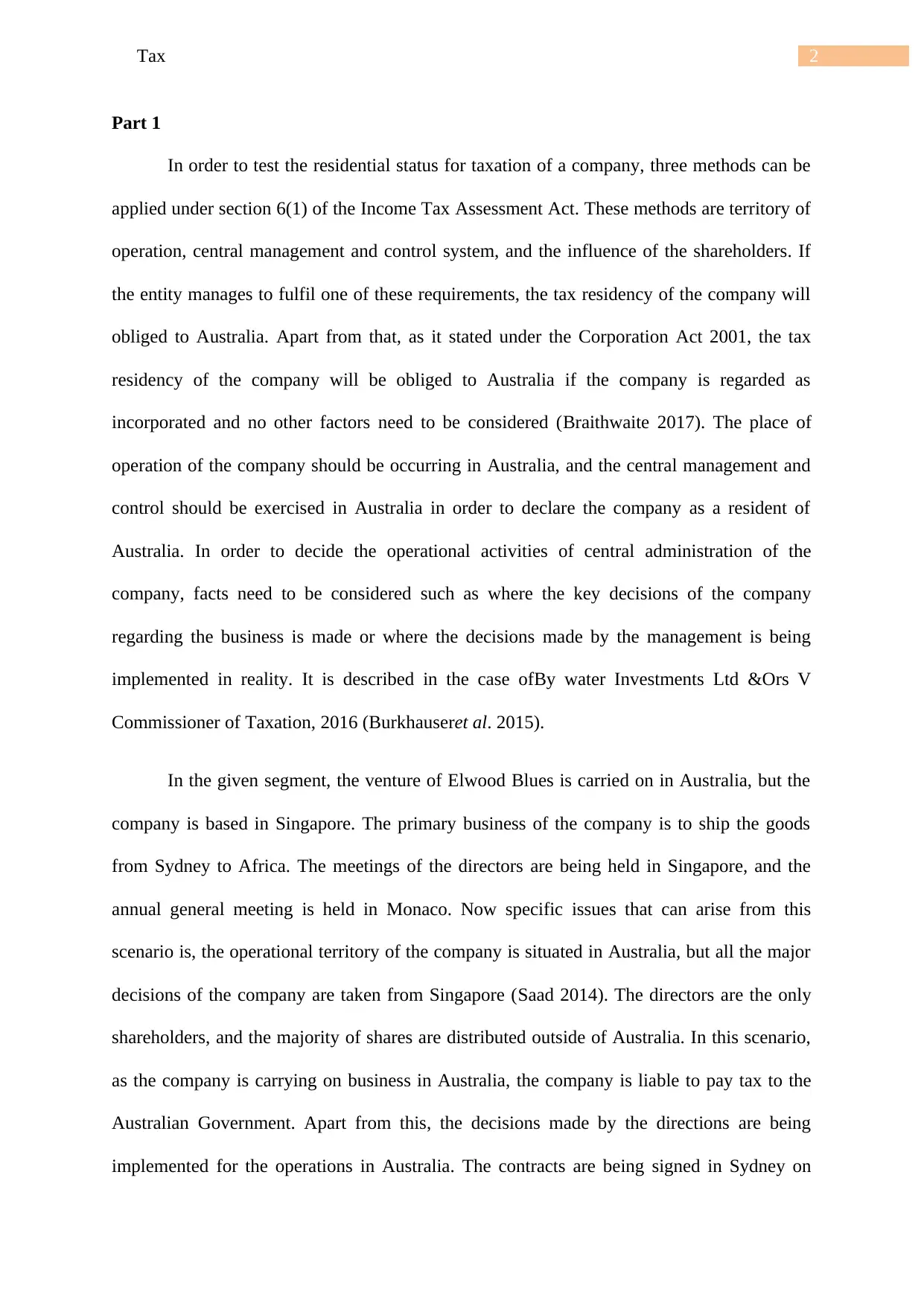
2Tax
Part 1
In order to test the residential status for taxation of a company, three methods can be
applied under section 6(1) of the Income Tax Assessment Act. These methods are territory of
operation, central management and control system, and the influence of the shareholders. If
the entity manages to fulfil one of these requirements, the tax residency of the company will
obliged to Australia. Apart from that, as it stated under the Corporation Act 2001, the tax
residency of the company will be obliged to Australia if the company is regarded as
incorporated and no other factors need to be considered (Braithwaite 2017). The place of
operation of the company should be occurring in Australia, and the central management and
control should be exercised in Australia in order to declare the company as a resident of
Australia. In order to decide the operational activities of central administration of the
company, facts need to be considered such as where the key decisions of the company
regarding the business is made or where the decisions made by the management is being
implemented in reality. It is described in the case ofBy water Investments Ltd &Ors V
Commissioner of Taxation, 2016 (Burkhauseret al. 2015).
In the given segment, the venture of Elwood Blues is carried on in Australia, but the
company is based in Singapore. The primary business of the company is to ship the goods
from Sydney to Africa. The meetings of the directors are being held in Singapore, and the
annual general meeting is held in Monaco. Now specific issues that can arise from this
scenario is, the operational territory of the company is situated in Australia, but all the major
decisions of the company are taken from Singapore (Saad 2014). The directors are the only
shareholders, and the majority of shares are distributed outside of Australia. In this scenario,
as the company is carrying on business in Australia, the company is liable to pay tax to the
Australian Government. Apart from this, the decisions made by the directions are being
implemented for the operations in Australia. The contracts are being signed in Sydney on
Part 1
In order to test the residential status for taxation of a company, three methods can be
applied under section 6(1) of the Income Tax Assessment Act. These methods are territory of
operation, central management and control system, and the influence of the shareholders. If
the entity manages to fulfil one of these requirements, the tax residency of the company will
obliged to Australia. Apart from that, as it stated under the Corporation Act 2001, the tax
residency of the company will be obliged to Australia if the company is regarded as
incorporated and no other factors need to be considered (Braithwaite 2017). The place of
operation of the company should be occurring in Australia, and the central management and
control should be exercised in Australia in order to declare the company as a resident of
Australia. In order to decide the operational activities of central administration of the
company, facts need to be considered such as where the key decisions of the company
regarding the business is made or where the decisions made by the management is being
implemented in reality. It is described in the case ofBy water Investments Ltd &Ors V
Commissioner of Taxation, 2016 (Burkhauseret al. 2015).
In the given segment, the venture of Elwood Blues is carried on in Australia, but the
company is based in Singapore. The primary business of the company is to ship the goods
from Sydney to Africa. The meetings of the directors are being held in Singapore, and the
annual general meeting is held in Monaco. Now specific issues that can arise from this
scenario is, the operational territory of the company is situated in Australia, but all the major
decisions of the company are taken from Singapore (Saad 2014). The directors are the only
shareholders, and the majority of shares are distributed outside of Australia. In this scenario,
as the company is carrying on business in Australia, the company is liable to pay tax to the
Australian Government. Apart from this, the decisions made by the directions are being
implemented for the operations in Australia. The contracts are being signed in Sydney on
⊘ This is a preview!⊘
Do you want full access?
Subscribe today to unlock all pages.

Trusted by 1+ million students worldwide
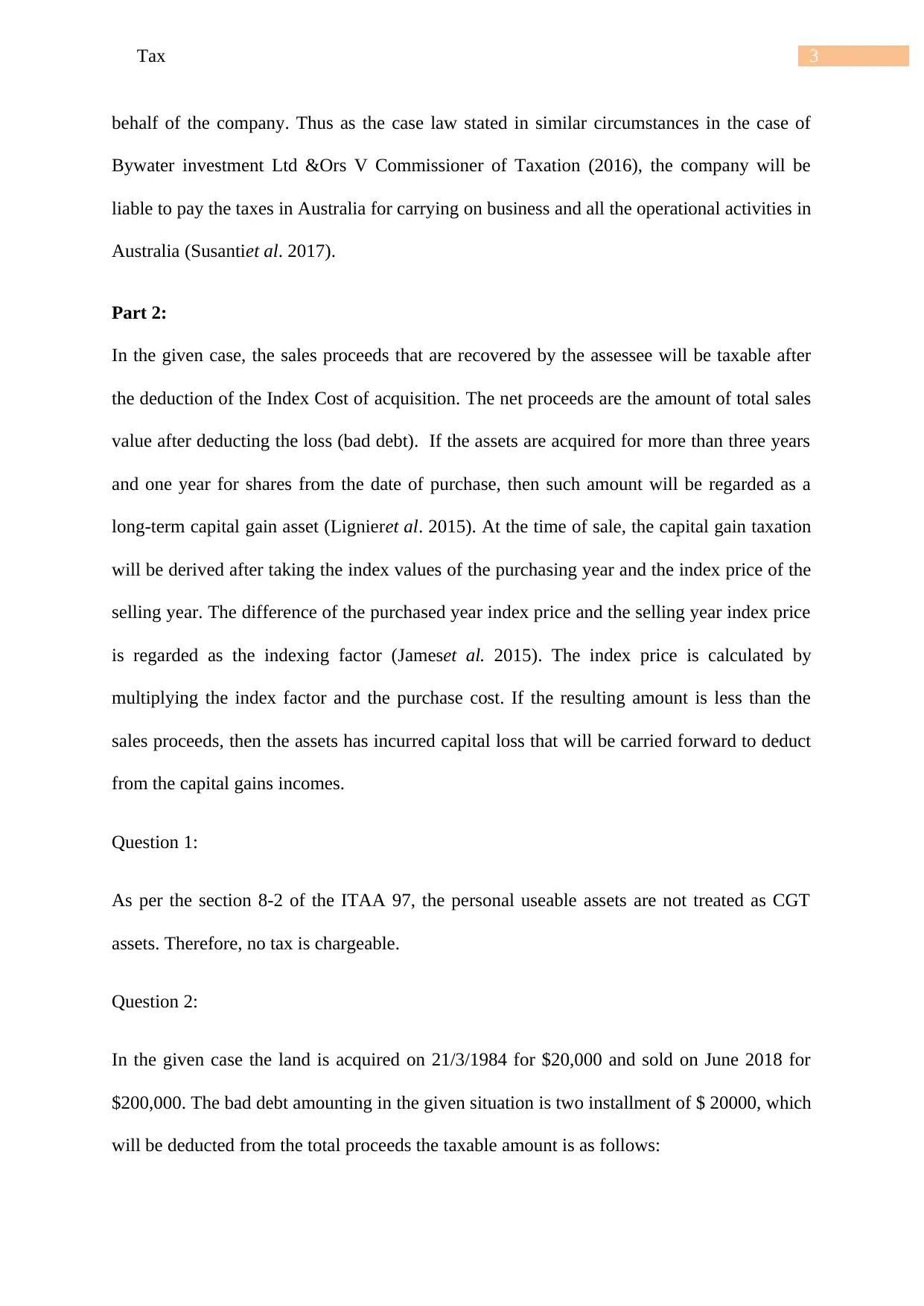
3Tax
behalf of the company. Thus as the case law stated in similar circumstances in the case of
Bywater investment Ltd &Ors V Commissioner of Taxation (2016), the company will be
liable to pay the taxes in Australia for carrying on business and all the operational activities in
Australia (Susantiet al. 2017).
Part 2:
In the given case, the sales proceeds that are recovered by the assessee will be taxable after
the deduction of the Index Cost of acquisition. The net proceeds are the amount of total sales
value after deducting the loss (bad debt). If the assets are acquired for more than three years
and one year for shares from the date of purchase, then such amount will be regarded as a
long-term capital gain asset (Lignieret al. 2015). At the time of sale, the capital gain taxation
will be derived after taking the index values of the purchasing year and the index price of the
selling year. The difference of the purchased year index price and the selling year index price
is regarded as the indexing factor (Jameset al. 2015). The index price is calculated by
multiplying the index factor and the purchase cost. If the resulting amount is less than the
sales proceeds, then the assets has incurred capital loss that will be carried forward to deduct
from the capital gains incomes.
Question 1:
As per the section 8-2 of the ITAA 97, the personal useable assets are not treated as CGT
assets. Therefore, no tax is chargeable.
Question 2:
In the given case the land is acquired on 21/3/1984 for $20,000 and sold on June 2018 for
$200,000. The bad debt amounting in the given situation is two installment of $ 20000, which
will be deducted from the total proceeds the taxable amount is as follows:
behalf of the company. Thus as the case law stated in similar circumstances in the case of
Bywater investment Ltd &Ors V Commissioner of Taxation (2016), the company will be
liable to pay the taxes in Australia for carrying on business and all the operational activities in
Australia (Susantiet al. 2017).
Part 2:
In the given case, the sales proceeds that are recovered by the assessee will be taxable after
the deduction of the Index Cost of acquisition. The net proceeds are the amount of total sales
value after deducting the loss (bad debt). If the assets are acquired for more than three years
and one year for shares from the date of purchase, then such amount will be regarded as a
long-term capital gain asset (Lignieret al. 2015). At the time of sale, the capital gain taxation
will be derived after taking the index values of the purchasing year and the index price of the
selling year. The difference of the purchased year index price and the selling year index price
is regarded as the indexing factor (Jameset al. 2015). The index price is calculated by
multiplying the index factor and the purchase cost. If the resulting amount is less than the
sales proceeds, then the assets has incurred capital loss that will be carried forward to deduct
from the capital gains incomes.
Question 1:
As per the section 8-2 of the ITAA 97, the personal useable assets are not treated as CGT
assets. Therefore, no tax is chargeable.
Question 2:
In the given case the land is acquired on 21/3/1984 for $20,000 and sold on June 2018 for
$200,000. The bad debt amounting in the given situation is two installment of $ 20000, which
will be deducted from the total proceeds the taxable amount is as follows:
Paraphrase This Document
Need a fresh take? Get an instant paraphrase of this document with our AI Paraphraser
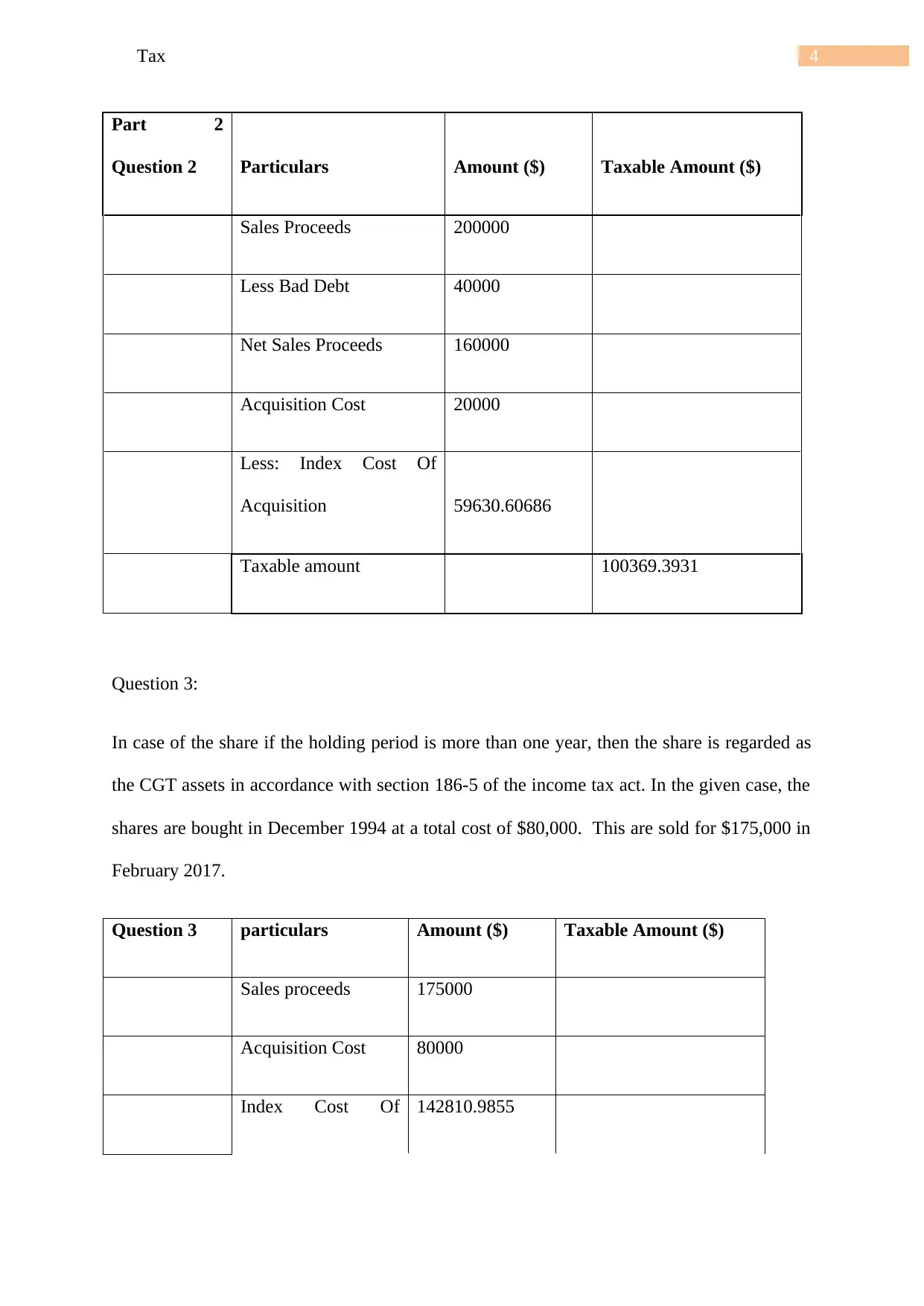
4Tax
Part 2
Question 2 Particulars Amount ($) Taxable Amount ($)
Sales Proceeds 200000
Less Bad Debt 40000
Net Sales Proceeds 160000
Acquisition Cost 20000
Less: Index Cost Of
Acquisition 59630.60686
Taxable amount 100369.3931
Question 3:
In case of the share if the holding period is more than one year, then the share is regarded as
the CGT assets in accordance with section 186-5 of the income tax act. In the given case, the
shares are bought in December 1994 at a total cost of $80,000. This are sold for $175,000 in
February 2017.
Question 3 particulars Amount ($) Taxable Amount ($)
Sales proceeds 175000
Acquisition Cost 80000
Index Cost Of 142810.9855
Part 2
Question 2 Particulars Amount ($) Taxable Amount ($)
Sales Proceeds 200000
Less Bad Debt 40000
Net Sales Proceeds 160000
Acquisition Cost 20000
Less: Index Cost Of
Acquisition 59630.60686
Taxable amount 100369.3931
Question 3:
In case of the share if the holding period is more than one year, then the share is regarded as
the CGT assets in accordance with section 186-5 of the income tax act. In the given case, the
shares are bought in December 1994 at a total cost of $80,000. This are sold for $175,000 in
February 2017.
Question 3 particulars Amount ($) Taxable Amount ($)
Sales proceeds 175000
Acquisition Cost 80000
Index Cost Of 142810.9855
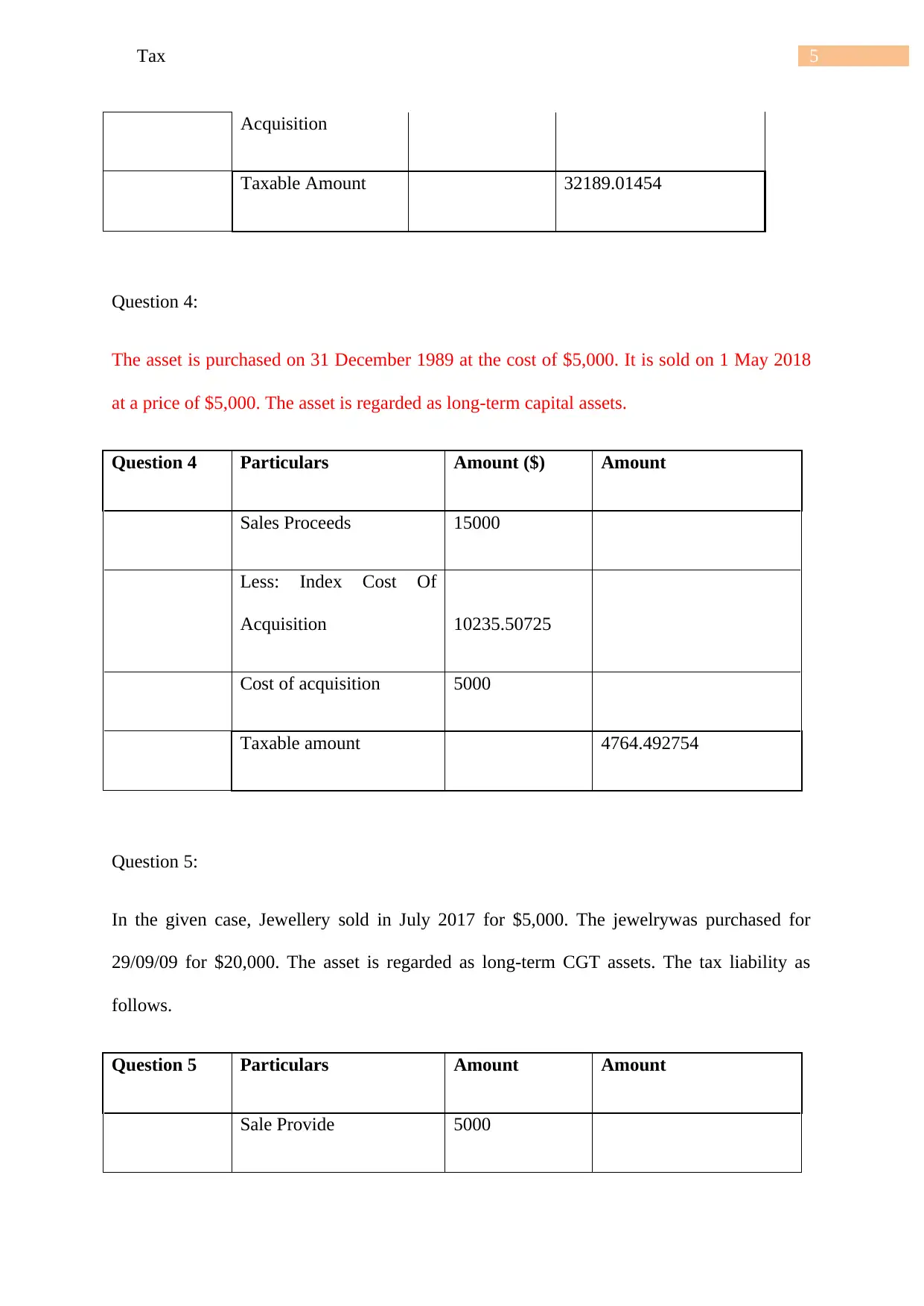
5Tax
Acquisition
Taxable Amount 32189.01454
Question 4:
The asset is purchased on 31 December 1989 at the cost of $5,000. It is sold on 1 May 2018
at a price of $5,000. The asset is regarded as long-term capital assets.
Question 4 Particulars Amount ($) Amount
Sales Proceeds 15000
Less: Index Cost Of
Acquisition 10235.50725
Cost of acquisition 5000
Taxable amount 4764.492754
Question 5:
In the given case, Jewellery sold in July 2017 for $5,000. The jewelrywas purchased for
29/09/09 for $20,000. The asset is regarded as long-term CGT assets. The tax liability as
follows.
Question 5 Particulars Amount Amount
Sale Provide 5000
Acquisition
Taxable Amount 32189.01454
Question 4:
The asset is purchased on 31 December 1989 at the cost of $5,000. It is sold on 1 May 2018
at a price of $5,000. The asset is regarded as long-term capital assets.
Question 4 Particulars Amount ($) Amount
Sales Proceeds 15000
Less: Index Cost Of
Acquisition 10235.50725
Cost of acquisition 5000
Taxable amount 4764.492754
Question 5:
In the given case, Jewellery sold in July 2017 for $5,000. The jewelrywas purchased for
29/09/09 for $20,000. The asset is regarded as long-term CGT assets. The tax liability as
follows.
Question 5 Particulars Amount Amount
Sale Provide 5000
⊘ This is a preview!⊘
Do you want full access?
Subscribe today to unlock all pages.

Trusted by 1+ million students worldwide
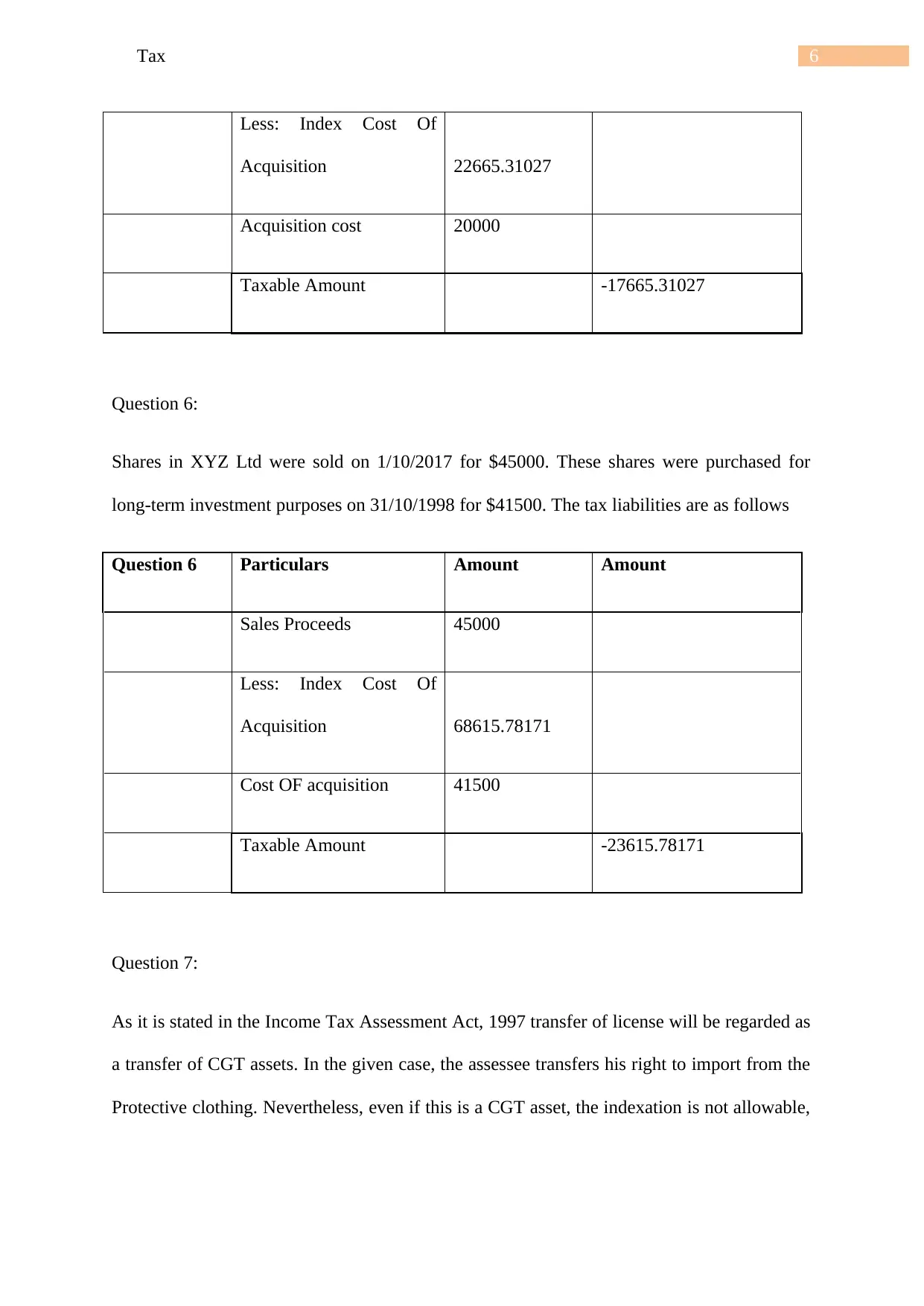
6Tax
Less: Index Cost Of
Acquisition 22665.31027
Acquisition cost 20000
Taxable Amount -17665.31027
Question 6:
Shares in XYZ Ltd were sold on 1/10/2017 for $45000. These shares were purchased for
long-term investment purposes on 31/10/1998 for $41500. The tax liabilities are as follows
Question 6 Particulars Amount Amount
Sales Proceeds 45000
Less: Index Cost Of
Acquisition 68615.78171
Cost OF acquisition 41500
Taxable Amount -23615.78171
Question 7:
As it is stated in the Income Tax Assessment Act, 1997 transfer of license will be regarded as
a transfer of CGT assets. In the given case, the assessee transfers his right to import from the
Protective clothing. Nevertheless, even if this is a CGT asset, the indexation is not allowable,
Less: Index Cost Of
Acquisition 22665.31027
Acquisition cost 20000
Taxable Amount -17665.31027
Question 6:
Shares in XYZ Ltd were sold on 1/10/2017 for $45000. These shares were purchased for
long-term investment purposes on 31/10/1998 for $41500. The tax liabilities are as follows
Question 6 Particulars Amount Amount
Sales Proceeds 45000
Less: Index Cost Of
Acquisition 68615.78171
Cost OF acquisition 41500
Taxable Amount -23615.78171
Question 7:
As it is stated in the Income Tax Assessment Act, 1997 transfer of license will be regarded as
a transfer of CGT assets. In the given case, the assessee transfers his right to import from the
Protective clothing. Nevertheless, even if this is a CGT asset, the indexation is not allowable,
Paraphrase This Document
Need a fresh take? Get an instant paraphrase of this document with our AI Paraphraser
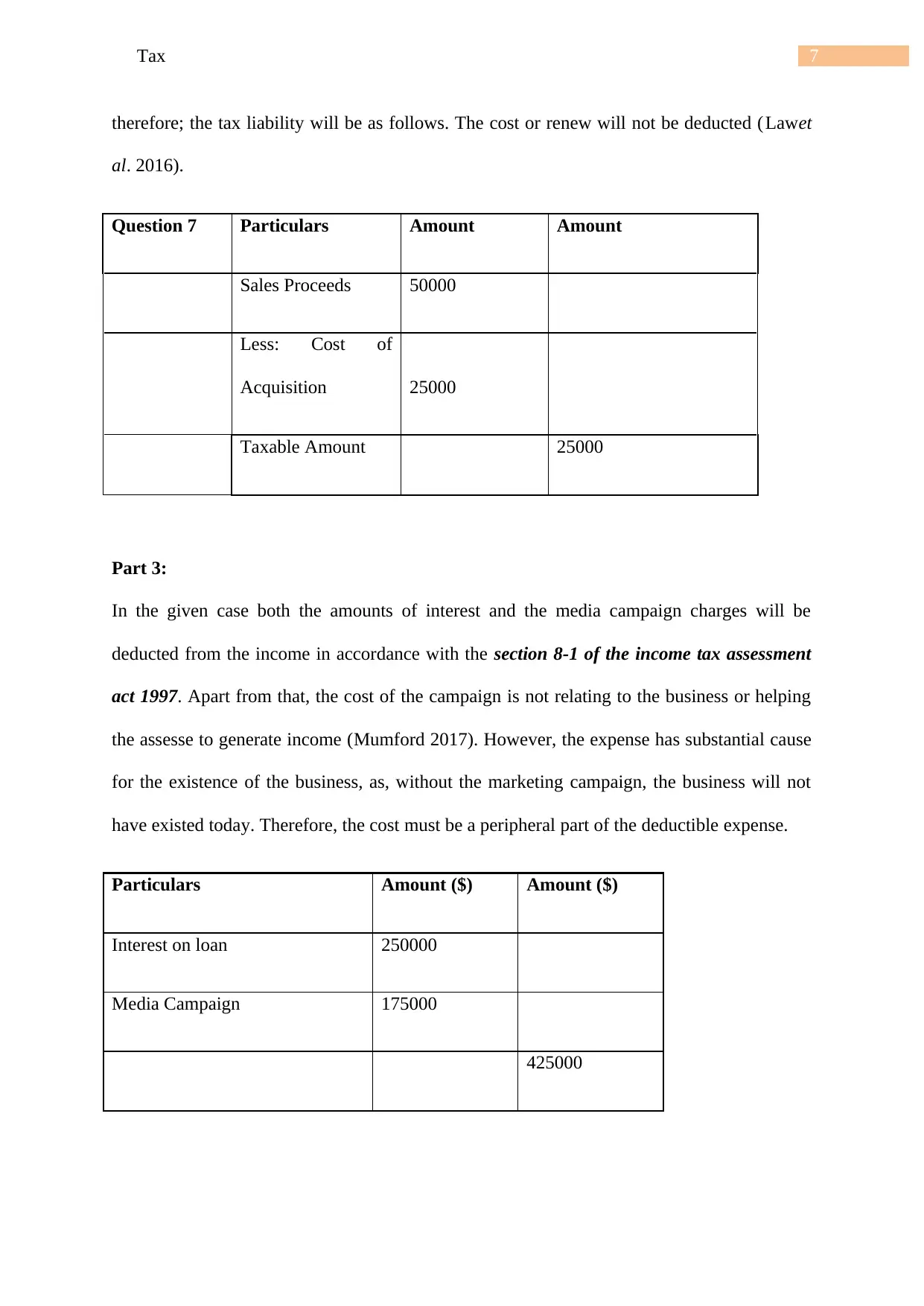
7Tax
therefore; the tax liability will be as follows. The cost or renew will not be deducted (Lawet
al. 2016).
Question 7 Particulars Amount Amount
Sales Proceeds 50000
Less: Cost of
Acquisition 25000
Taxable Amount 25000
Part 3:
In the given case both the amounts of interest and the media campaign charges will be
deducted from the income in accordance with the section 8-1 of the income tax assessment
act 1997. Apart from that, the cost of the campaign is not relating to the business or helping
the assesse to generate income (Mumford 2017). However, the expense has substantial cause
for the existence of the business, as, without the marketing campaign, the business will not
have existed today. Therefore, the cost must be a peripheral part of the deductible expense.
Particulars Amount ($) Amount ($)
Interest on loan 250000
Media Campaign 175000
425000
therefore; the tax liability will be as follows. The cost or renew will not be deducted (Lawet
al. 2016).
Question 7 Particulars Amount Amount
Sales Proceeds 50000
Less: Cost of
Acquisition 25000
Taxable Amount 25000
Part 3:
In the given case both the amounts of interest and the media campaign charges will be
deducted from the income in accordance with the section 8-1 of the income tax assessment
act 1997. Apart from that, the cost of the campaign is not relating to the business or helping
the assesse to generate income (Mumford 2017). However, the expense has substantial cause
for the existence of the business, as, without the marketing campaign, the business will not
have existed today. Therefore, the cost must be a peripheral part of the deductible expense.
Particulars Amount ($) Amount ($)
Interest on loan 250000
Media Campaign 175000
425000
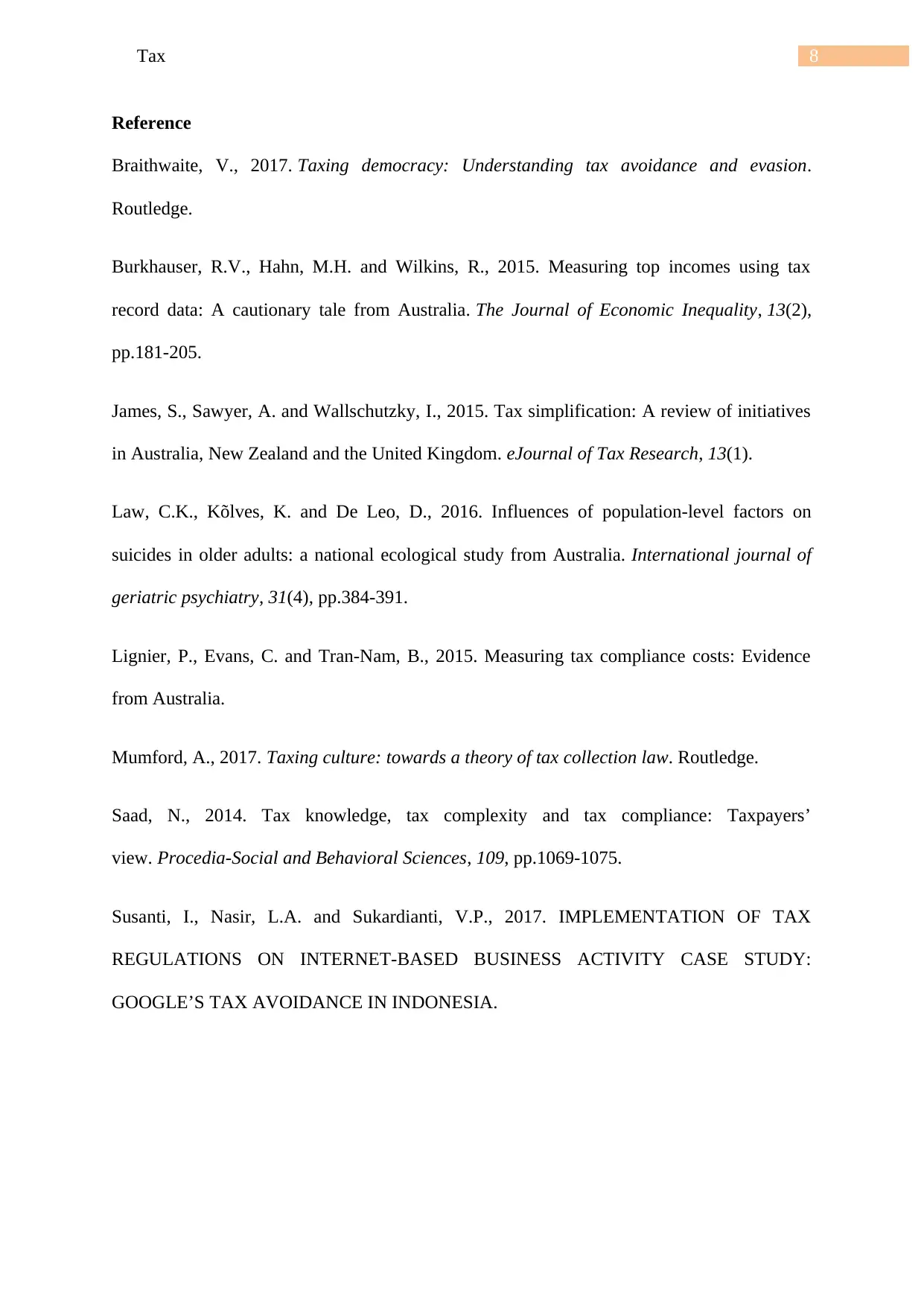
8Tax
Reference
Braithwaite, V., 2017. Taxing democracy: Understanding tax avoidance and evasion.
Routledge.
Burkhauser, R.V., Hahn, M.H. and Wilkins, R., 2015. Measuring top incomes using tax
record data: A cautionary tale from Australia. The Journal of Economic Inequality, 13(2),
pp.181-205.
James, S., Sawyer, A. and Wallschutzky, I., 2015. Tax simplification: A review of initiatives
in Australia, New Zealand and the United Kingdom. eJournal of Tax Research, 13(1).
Law, C.K., Kõlves, K. and De Leo, D., 2016. Influences of population‐level factors on
suicides in older adults: a national ecological study from Australia. International journal of
geriatric psychiatry, 31(4), pp.384-391.
Lignier, P., Evans, C. and Tran-Nam, B., 2015. Measuring tax compliance costs: Evidence
from Australia.
Mumford, A., 2017. Taxing culture: towards a theory of tax collection law. Routledge.
Saad, N., 2014. Tax knowledge, tax complexity and tax compliance: Taxpayers’
view. Procedia-Social and Behavioral Sciences, 109, pp.1069-1075.
Susanti, I., Nasir, L.A. and Sukardianti, V.P., 2017. IMPLEMENTATION OF TAX
REGULATIONS ON INTERNET-BASED BUSINESS ACTIVITY CASE STUDY:
GOOGLE’S TAX AVOIDANCE IN INDONESIA.
Reference
Braithwaite, V., 2017. Taxing democracy: Understanding tax avoidance and evasion.
Routledge.
Burkhauser, R.V., Hahn, M.H. and Wilkins, R., 2015. Measuring top incomes using tax
record data: A cautionary tale from Australia. The Journal of Economic Inequality, 13(2),
pp.181-205.
James, S., Sawyer, A. and Wallschutzky, I., 2015. Tax simplification: A review of initiatives
in Australia, New Zealand and the United Kingdom. eJournal of Tax Research, 13(1).
Law, C.K., Kõlves, K. and De Leo, D., 2016. Influences of population‐level factors on
suicides in older adults: a national ecological study from Australia. International journal of
geriatric psychiatry, 31(4), pp.384-391.
Lignier, P., Evans, C. and Tran-Nam, B., 2015. Measuring tax compliance costs: Evidence
from Australia.
Mumford, A., 2017. Taxing culture: towards a theory of tax collection law. Routledge.
Saad, N., 2014. Tax knowledge, tax complexity and tax compliance: Taxpayers’
view. Procedia-Social and Behavioral Sciences, 109, pp.1069-1075.
Susanti, I., Nasir, L.A. and Sukardianti, V.P., 2017. IMPLEMENTATION OF TAX
REGULATIONS ON INTERNET-BASED BUSINESS ACTIVITY CASE STUDY:
GOOGLE’S TAX AVOIDANCE IN INDONESIA.
⊘ This is a preview!⊘
Do you want full access?
Subscribe today to unlock all pages.

Trusted by 1+ million students worldwide
1 out of 9
Related Documents
Your All-in-One AI-Powered Toolkit for Academic Success.
+13062052269
info@desklib.com
Available 24*7 on WhatsApp / Email
![[object Object]](/_next/static/media/star-bottom.7253800d.svg)
Unlock your academic potential
Copyright © 2020–2025 A2Z Services. All Rights Reserved. Developed and managed by ZUCOL.





